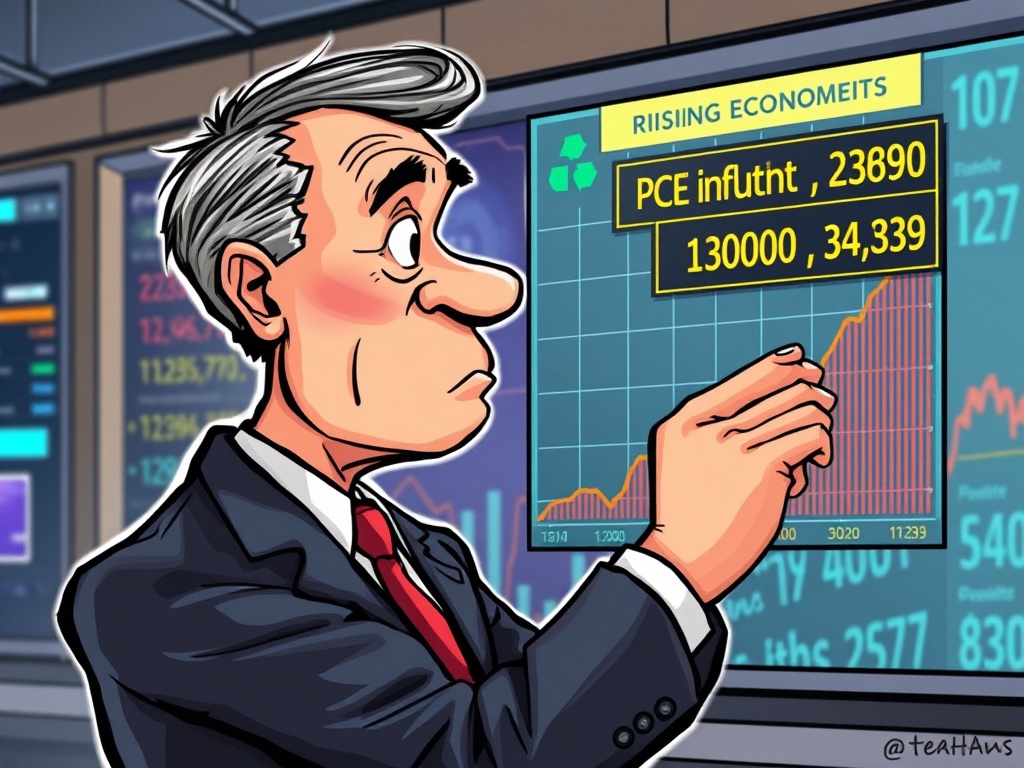BitcoinWorld

PCE Inflation: Crucial Data Unveils Surprising Economic Shifts
In the dynamic world of cryptocurrency, where market sentiment can shift in an instant, every economic report from traditional finance holds significant weight. The latest release from the U.S. Bureau of Economic Analysis concerning the personal consumption expenditures (PCE) price index is no exception. This isn’t just a dry economic statistic; it’s a crucial piece of the puzzle that helps shape Federal Reserve policy, and by extension, the landscape for your digital asset investments. Understanding the nuances of the June PCE inflation report is paramount for any savvy crypto investor looking to navigate the intricate currents of the global economy.
What is PCE Inflation and Why Does it Matter for Your Crypto Portfolio?
Before diving into the numbers, let’s clarify what PCE inflation is and why it commands so much attention, especially from the Federal Reserve. The PCE price index measures the average increase in prices paid by consumers for goods and services. While you might be more familiar with the Consumer Price Index (CPI), the PCE is the Federal Reserve’s preferred gauge of inflation. Why? Because it offers a broader measure of consumer spending, accounts for changes in consumer behavior (i.e., substituting cheaper goods when prices rise), and covers a wider range of goods and services.
- Broader Scope: PCE includes a wider range of goods and services than CPI.
- Consumer Behavior: It adapts to how consumers change their spending habits in response to price changes.
- Fed’s Focus: The Federal Reserve explicitly targets 2% PCE inflation as part of its dual mandate for stable prices and maximum employment.
For crypto investors, this distinction is vital. The Fed’s reaction to PCE inflation directly impacts interest rates, the strength of the U.S. dollar, and overall market liquidity—all factors that profoundly influence risk assets like cryptocurrencies.
June’s PCE Inflation Data Unpacked: A Closer Look at the Numbers
The recent report delivered figures that largely aligned with expectations, yet with a subtle twist in the core metric. Here’s a breakdown of the key figures for June:
| Metric | June 2024 Reading | Analyst Expectations | Previous Month (May 2024) |
|---|---|---|---|
| PCE Price Index (Month-over-month) | +0.3% | +0.3% | +0.2% |
| Core PCE Price Index (Year-over-year) | +2.8% | +2.7% | +2.6% |
The headline PCE price index increased by 0.3% month-over-month, perfectly matching economists’ forecasts. This suggests a continued, albeit moderate, pace of price increases across the board. However, the year-over-year core PCE, which strips out volatile food and energy prices, saw a rise of 2.8%. This figure, while seemingly a small deviation, was slightly above the anticipated 2.7% and represents an uptick from the previous month’s 2.6%. This subtle acceleration in core PCE inflation is where the market’s attention truly zeroes in, as it indicates underlying price pressures that could persist.
How Does PCE Inflation Influence Federal Reserve Policy?
The Federal Reserve’s primary goal regarding inflation is to achieve price stability, which it defines as a 2% annual rate for the core PCE. When PCE inflation runs consistently above this target, the Fed typically responds by tightening monetary policy—primarily by raising the federal funds rate. Higher interest rates make borrowing more expensive, which can cool down economic activity, reduce demand, and, in theory, bring inflation back down.
The 2.8% core PCE reading, while closer to the 2% target than previous highs, still signals that inflation is not yet fully under control. This slightly higher-than-expected figure could reinforce the Fed’s hawkish stance, meaning they might feel less pressure to pause or cut interest rates in the near term. For crypto, this often translates to a less favorable environment, as higher interest rates can make traditional investments more attractive relative to riskier assets like digital currencies.
Navigating the Crypto Waters: Implications for Digital Assets
The interplay between traditional economic data and the cryptocurrency market is complex but undeniable. Here’s how the latest PCE inflation report could ripple through your crypto portfolio:
- Interest Rate Expectations: A persistent or slightly accelerating core PCE strengthens the case for the Fed to maintain higher interest rates for longer, or even implement further hikes. Higher rates typically lead to a stronger U.S. dollar, which can put downward pressure on Bitcoin and other cryptocurrencies.
- Risk-Off Sentiment: When borrowing costs rise and economic uncertainty looms due to inflation concerns, investors often gravitate towards safer, less volatile assets. This ‘risk-off’ sentiment can lead to capital flowing out of cryptocurrencies.
- Liquidity Concerns: Tighter monetary policy reduces the overall liquidity in the financial system. Less readily available capital can mean reduced investment in speculative assets, impacting crypto market valuations.
- Investor Confidence: Ongoing inflation and the Fed’s response can erode investor confidence in the broader economy. While some view Bitcoin as an inflation hedge, its performance as such has been mixed, and general market unease can still trigger sell-offs.
Understanding these dynamics allows crypto investors to anticipate potential market movements rather than just reacting to them.
What’s Next? Anticipating the Fed’s Move and Market Reactions
With the June PCE inflation data now in hand, market participants are keenly watching the Federal Reserve’s next steps. The slightly elevated core PCE suggests that the path to the 2% target might be longer and bumpier than some had hoped. While one month’s data rarely dictates an entire policy shift, it adds to the cumulative evidence the Fed considers.
Expectations for future interest rate decisions will remain a dominant theme. Analysts will scrutinize every word from Fed officials for clues on whether the central bank believes it has done enough or if more tightening is required. This uncertainty can lead to continued volatility in both traditional and crypto markets. Crypto investors should prepare for a potentially prolonged period where macro factors continue to exert a strong influence.
Actionable Insights for Crypto Investors:
- Stay Informed: Continuously monitor key economic indicators like PCE, CPI, and employment data, as well as Fed announcements.
- Risk Management: Re-evaluate your portfolio’s risk exposure. Consider adjusting allocations based on your risk tolerance and market outlook.
- Long-Term Perspective: While short-term volatility is inevitable, remember the long-term potential of the crypto space. Focus on projects with strong fundamentals and clear use cases.
- Diversification: Explore diversification within your crypto portfolio and potentially across different asset classes to mitigate risk.
- Dollar Cost Averaging: Consider using strategies like dollar-cost averaging to mitigate the impact of price fluctuations.
Summary: The Enduring Impact of PCE Inflation on Your Digital Assets
The June PCE inflation report, particularly the slightly elevated core PCE, serves as a critical reminder that macroeconomic forces are powerful drivers in the cryptocurrency market. While the headline PCE met expectations, the persistent strength in core inflation signals that the Federal Reserve’s battle against rising prices is far from over. This ongoing struggle has direct implications for interest rates, liquidity, and investor sentiment, all of which directly influence the trajectory of Bitcoin, Ethereum, and the broader altcoin market.
For crypto investors, this means maintaining vigilance, understanding the intricate connections between traditional economic data and digital asset performance, and adapting strategies to navigate periods of increased volatility. The journey towards price stability continues, and with it, the dynamic evolution of the crypto landscape.
Frequently Asked Questions (FAQs)
Q1: What is the primary difference between PCE and CPI inflation?
A1: The Consumer Price Index (CPI) measures prices of a fixed basket of goods and services typically purchased by urban consumers. The Personal Consumption Expenditures (PCE) price index, preferred by the Federal Reserve, measures a broader range of goods and services and adjusts for changes in consumer spending patterns, making it a more comprehensive gauge of inflation.
Q2: Why does the Federal Reserve prefer PCE over CPI for its inflation target?
A2: The Fed prefers PCE because it provides a more flexible and comprehensive measure of consumer spending, reflecting how consumers adapt to price changes by substituting goods and services. It also has a broader coverage of the economy, making it a more accurate indicator for monetary policy decisions.
Q3: How does high PCE inflation typically affect cryptocurrency prices?
A3: High PCE inflation often leads the Federal Reserve to implement tighter monetary policies, such as raising interest rates. Higher rates tend to strengthen the U.S. dollar and reduce overall market liquidity, which can make riskier assets like cryptocurrencies less attractive, often leading to price declines.
Q4: What should crypto investors do in response to rising PCE inflation?
A4: In response to rising PCE inflation, crypto investors should focus on risk management, potentially re-evaluating their portfolio’s exposure to volatile assets. Diversification, staying informed about macroeconomic trends, and considering long-term investment strategies like dollar-cost averaging can help navigate market uncertainty.
Q5: Will the Fed continue to raise interest rates based on this June PCE data?
A5: The slightly higher-than-expected core PCE reading for June could reinforce the Federal Reserve’s hawkish stance, suggesting that inflation remains persistent. While one report isn’t definitive, it adds to the evidence that the Fed may need to maintain higher interest rates for longer, or potentially consider further hikes, depending on future data.
If you found this analysis insightful and believe it can help others understand the complex interplay between economic data and the crypto market, please share this article on your social media channels. Your support helps us continue providing valuable insights to the crypto community!
To learn more about the latest crypto market trends, explore our article on key developments shaping Bitcoin price action.
This post PCE Inflation: Crucial Data Unveils Surprising Economic Shifts first appeared on BitcoinWorld and is written by Editorial Team





